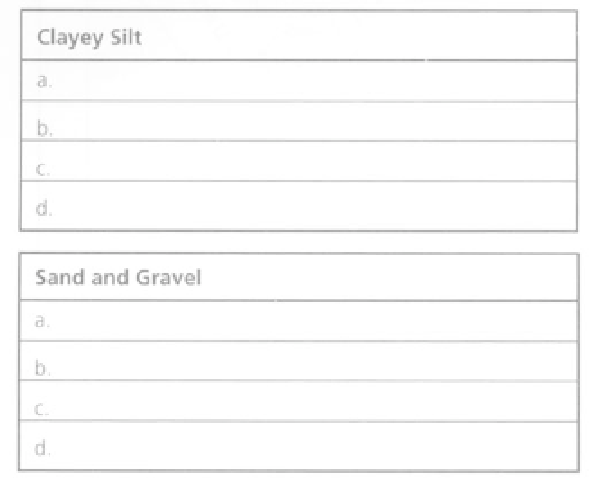Geology Reference
In-Depth Information
(cemented and compacted to solid rock) or unconsolidated?
Explain.
PART B. SUBSIDENCE IN THE SANTA CLARA
VALLEY, CALIFORNIA
The Santa Clara Valley was the first area in the United
States where land subsidence due to groundwater over-
draft was recognized. As of 1971 subsidence has been
stopped due to a reversal of the water-level decline.
The valley is a large structural trough filled with
over 1,500 ft of alluvium, including, in the lower part,
the semiconsolidated Santa Clara Formation of Pliocene
and Pleistocene age (Figure 9.2). Sand and gravel
aquifers predominate near the valley margins, but the
major part of the alluvium is fine grained.
Below a depth of 200 ft the groundwater is con-
fined by layers of clay, except near the margins. Initially
wells as far south as Santa Clara flowed, but decline in
head (water-pressure surface) occurred due to pumping
for agricultural purposes (90 percent of use until the
mid-1930s and 18 percent in 1967). By 1965 the artesian
head had declined 150 to 200 ft within most of the con-
fined area. The decline was not continuous; recharge of
the aquifer occurred between 1938 and 1947, in part
because of controlled infiltration from surface reservoirs.
Most of the wells tapping the artesian system
range from 500 to 1,000 ft in depth, although a few
reach 1,200 ft. Well yields in the valley range from 500
to 2,500 gal/min.
3. The geologic ages of these deposits are:
4.
What is the maximum depth of deposits that have been
compacted?
5.
The maximum recorded subsidence is
at
meters
.
QUESTIONS (9, PART B)
Refer to Figures 9.2 and 9.3, showing land subsidence for
two different periods, in answering the following questions.
1.
According to Figure 9.2, what locations showed maximum
subsidence in the Santa Clara Valley from 1934 to 1960?
6.
The sediments in major areas of subsidence consist of
interbedded clayey silt and sand and gravel. Place the fol-
lowing characteristics under the appropriate column above:
aquifer, low compressibility, low permeability, high perme-
ability, confining bed, fine-grained texture, coarse-grained
texture, and high compressibility.
2. a.
What was the total subsidence from 1934 to 1960 in these
areas?
b.
What was the average annual rate in these areas for this
period?
7. Subsidence induced by groundwater withdrawal gener-
ally occurs in areas characterized by confined aquifer sys-
tems. What is a confined aquifer?
3. What geologic material is largely responsible for the
subsidence?
8.
Confining beds consisting of clayey silt respond differ-
ently than sand and gravel. They may contain a great deal of
water (have high porosity), but it is not readily transmitted.
Such rocks are said to have a low
4. Would subsidence be more noticeable at Alviso (on the
Bay) or at Mountain View?
.
5.
What types of damage and geomorphic changes would
indicate subsidence?
9.
When the water pressure in the aquifer decreases, the water
in the confining beds may move slowly /rapidly (circle one)
into the aquifer. The result is a
in thickness
of the confining bed and possibly
of
the land surface (see Figure 9.1).





